Some Japanese fruit and seafood specialties, despite being expensive, are still popular and well-loved around the world.
Top 6 Famous Expensive Foods from Japan
The expensive foods from the land of cherry blossoms include not only wasabi, but also melons, Taiyo no Tamago mangoes, Ruby Roman grapes, unagi (eel), and sea urchin, all of which are considered premium ingredients.
These foods are expensive due to their specific growing conditions, long cultivation periods, extended farming processes, high risks, and labor-intensive care… all of which contribute to their high prices.
Wasabi
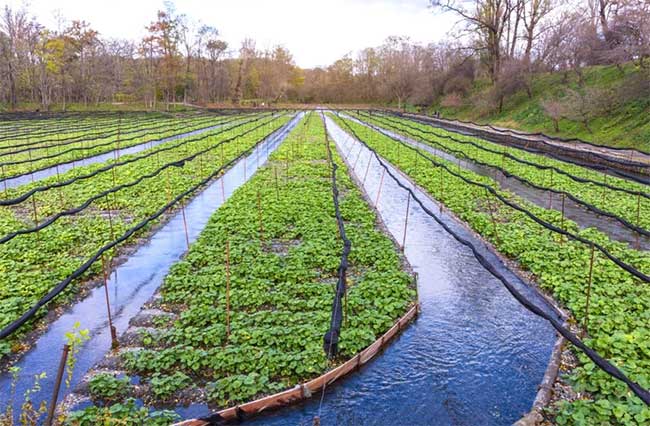
Wasabi plants in Nagano, Japan. They only grow in specific areas. (Photo: Shutterstock).
The green paste commonly served with sushi is not necessarily the wasabi you might think. Upon checking the ingredients, you’ll find that the actual wasabi content is very low in that mixture. Most of the wasabi served in restaurants or sold is made from dyed horseradish or other similar plants as substitutes.
Wasabi is known to be one of the most challenging crops to grow commercially in the world. Real wasabi is extremely rare and can cost up to 250 USD/kg.
The only place where wasabi can be found growing naturally is along streams with continuously flowing water in the mountainous regions of Japan. Conditions such as shade, temperature, and soil minerals must be met for these plants to thrive. They can only survive at temperatures between 8-20 degrees Celsius. In overly humid conditions or with unsuitable mineral content, wasabi is susceptible to pests.
Although wasabi is primarily grown in Japan, The Wasabi Company in Europe was one of the first companies to cultivate it for commercial purposes.
It takes about 18 months to harvest wasabi. The harvesting process is labor-intensive, arduous, and done entirely by hand.
When grinding or grating wasabi, the grater must have very fine “teeth” and no holes at the back. This special grater is used to turn wasabi into a paste. When tasting real wasabi, you will be surprised by its complex flavor that stimulates the nose, followed by a characteristic sweetness after the spiciness.
Unagi
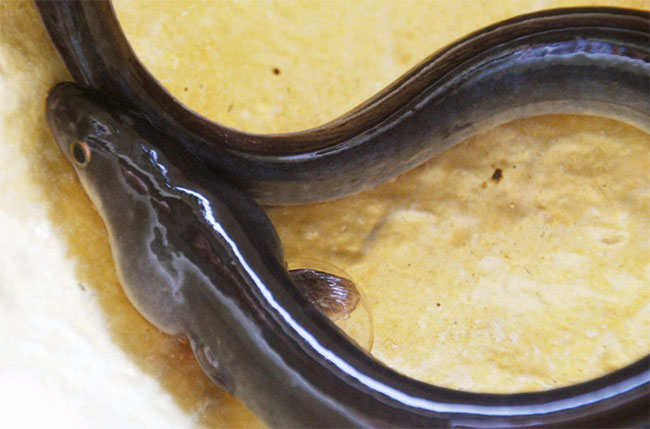
An eel farmed in Hamamatsu, Japan. (Photo: Getty Images).
Unagi (Japanese eel or freshwater eel) can be more expensive than bluefin tuna. Japanese eel has been a delicacy for thousands of years, but overfishing has led to a decline in their population.
Due to high demand, Japanese eel is becoming increasingly expensive. In January 2018, young eels, also known as glass eels, were priced at around 35,000 USD/kg.
These young eels are caught and farmed, requiring daily monitoring by farmers. If a disease spreads or an unfortunate event occurs, the entire stock of eels can be lost. Feeding the eels 2-3 times a day is also a costly task. Eels are omnivorous animals, and their feed typically consists of a mix of fish meal, wheat, soybean meal, and fish oil. After 6-12 months of care, the eels mature enough to be sold.
Taiyo no Tamago

Taiyo no Tamago mangoes can be sold for 4,000 USD per pair. (Photo: Getty Images).
This premium red-pink mango variety is also known as “sun egg.” These sweet mangoes are only grown in Miyazaki Prefecture, Japan. They are typically auctioned in pairs, with an average price of around 4,000 USD.
Bees play a crucial role in the pollination of these crops. They are released to help the mangoes develop and ripen. However, even if the trees are pollinated by bees, it does not guarantee that all the mangoes will qualify as Taiyo no Tamago.
These mangoes require a lot of sunlight to achieve the perfect appearance with their characteristic red color, plumpness, and no blemishes. For mangoes auctioned, in addition to the above factors, their skin must be free of green spots, weigh more than 350 grams, and have a sugar content of at least 15%.
Ruby Roman Grapes
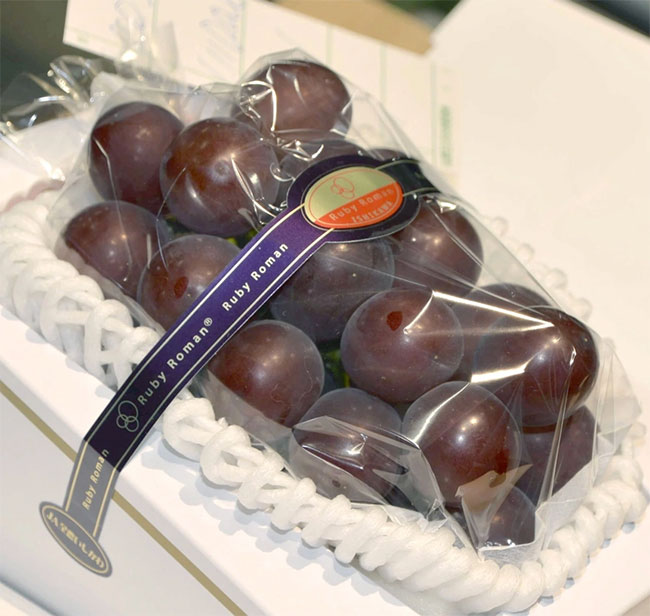
Ruby Roman grapes stand out for their size, uniform color, and flavor. (Photo: Getty Images).
This extremely expensive grape variety is called “Ruby Roman” and is grown in Ishikawa Prefecture, Central Japan. This grape is particularly famous for its high sweetness and low acidity. Each grape is about four times larger than a regular grape. Farmers in Ishikawa have been researching how to cultivate this rare grape variety for about 15 years. A standard bunch of grapes can sell for 90-450 USD.
They are distinguished by their size, uniform color, and flavor. Each grape must weigh at least 20 grams and be about 30 mm long, with a sugar content exceeding 18% – measured by a special refractometer. All these factors influence the classification of Ruby Roman grapes, helping to accurately determine their final value.
The grapes are grown in greenhouses, allowing farmers to better control their development. The grapes are carefully monitored and pruned to ensure that each grape in the bunch is uniform. Light and temperature are crucial factors for the grapes to ripen with the desired color and shape.
Sea Urchin
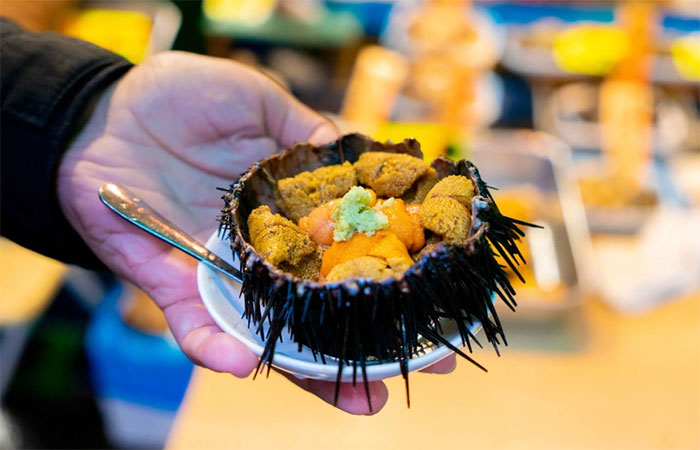
Sea urchins, also known as uni in Japanese, are a type of expensive seafood. (Photo: Shutterstock).
Red sea urchins are seafood that divers must collect by hand. They can be found on the seabed in Santa Barbara, California (USA). The amount of kelp in the water affects how many quality sea urchins can be harvested. When there is a lack of kelp, sea urchins are less prevalent.
After collecting all the sea urchins, they are sent to processing facilities. The most important step is cleaning the sea urchin roe. Here, the intestines and gonads are carefully removed to preserve freshness. It’s crucial not to separate any part of the gonads; otherwise, their value and quality will decrease.
When the spiny shell of the sea urchin is removed, you can see the valuable parts inside, which are the reproductive organs. Workers sort the sea urchin roe into boxes, selecting the parts that are uniformly orange or yellow. After sorting, they use tweezers for a final check and cleaning.
The roe (sea urchin eggs) can range in color from deep yellow to pale yellow, with a buttery texture, fine granules, and firmness. They are smooth, mildly fragrant, sweet, and slightly salty, often enjoyed in sushi nigiri or sashimi.
A 200-gram tray of sea urchin roe can sell for up to 100 USD. In Japan, the price can sometimes be five times higher.
Japanese Melon
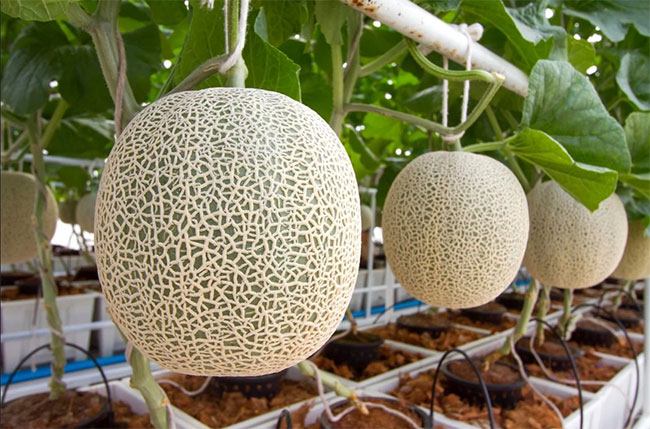
The cultivation of melons in Japan is complex and requires patience and meticulous care. (Photo: Shutterstock).
This type of melon is grown in Central Japan and can cost over 200 USD. In 2019, a famous yellow melon reached a record auction price of 45,000 USD per pair.
It takes 100 days for one of these melons to fully develop, requiring regular attention and care from farmers. The external appearance of the melon and its sugar content determine its value.
The melons are grown on raised beds and separated from the ground. This helps farmers accurately control the amount of water each plant receives. Climate control and heating maintain a stable temperature, allowing melons to be harvested year-round.
Despite the high cost, the demand for this fruit across Japan remains strong. This luxurious fruit is a part of Japanese gift-giving culture.




















































